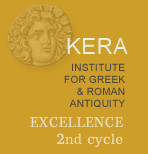Main Site . İbecik
55. Funerary inscription setting a monetary penalty against tomb violators
![]()
5 |
------------ (unknown number of lines) -------------- εἰς τόδε τὸ ἡρῷον ἐκτὸς εἰ μή τινι αὐτὸς ἐγὼ ζῶν ἔτι συνχωρήσω ἢ διατάξωμαι. Eἰ δέ τις ἕτερος ἐπεισενέν– κη καὶ κατάθηταί τινα, δώσει τῇ γλυκυτάτῃ πατρίδι μου προστείμου (δηνάρια) πεντακισχείλια καὶ ὑπεύθυνος ἔσ- ται τυμβωρυχίᾳ. |
[-----] in this grave, unless I myself allow while still alive or order by will. But if someone else brings in and buries someone, he will pay my beloved9 city 5000 denarii in fine and will be answerable for grave-robbing.
Door lintel of a tomb with fasciae, first found and documented in a field near İbecik apparently by Daniels, Bean and Schindler in 1842. The inscription was published much later by Collignon based on his own study of the stone. The Wiener Akademie holds a third documentation made in 1895 by Heberdey.
Height of the inscribed fasciae: 6 and 8 cm; width: 106 cm; size of the letters not available.
Collignon 1879, pp. 41-43, no. 4; Schindler 1972, no. 26 (p. 52: Heberdey's drawing); BullÉp 1973, no. 461; Milner 1998, p. 4, no. 2.7.
Schindler's text is based both on Collignon's and Heberdey's drawings. On fines for tomb violators Strubbe 1997, pp. 235-242 (Cibyra, Balboura and Oinoanda); McLean 2002, pp. 275-276.

